2005 – 2006 Trees Count! Street Tree Census
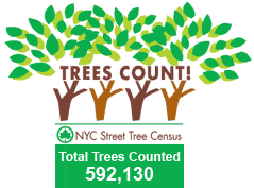
Just in time for Arbor Day, on April 26, 2007, Parks announced green news–New York City was already 100,000 street trees greener than it was ten years before that, and the City would plant a million more trees under Mayor Bloomberg’s PlaNYC.
The Parks Department announced the results of the second citywide count of trees that grow on New York City streets and are managed by Parks. The 2005-2006 Street Tree Census found 592,130 street trees–a 19 percent increase over the 1995-1996 census. Thanks to 1,100 volunteers and a sophisticated computer software program, New Yorkers now have a way to quantify the enormous benefits of New York’s street trees–from pollution reduction to savings on air conditioning bills. Street trees provide almost $122 million in benefits annually to City residents and are one of the best investments around.
Over the course of two summers, volunteers fanned out across the City to record information (such as size, species, location, and condition) for every street tree in New York City, logging a total of more than 30,000 volunteer hours. The United States Forest Service analyzed the data using a computer modeling program based on tree growth curves, climate data, and regional patterns of energy use, pollution levels, and building construction to quantify the dollar value of annual environmental and aesthetic benefits of each of the trees surveyed.
In 1995 New Yorkers joined together to count their trees, creating a baseline inventory of the City's street trees. Ten years later, on April 29, 2005, Parks Commissioner Adrian Benepe rallied the troops to once again enumerate the arboricultural assets that grace the streets and sidewalks of New York City. Equipped with maps, clipboards, tape measures, and tree identification keys, surveyors enumerated trees by species, size, location and condition in neighborhoods across New York City. With over a thousand volunteers logging a total of 30,000 hours, the effort represents the largest participatory urban forestry project in any city in the United States.
The tree census is an important scientific, technical, and educational effort. The results enable us to characterize our street tree population in terms of its structure, function, and value. This information is used in a variety of ways, including:
- Management.
Enables daily and strategic decision-making based on the composition, condition, and distribution of street trees. - Education.
Educating the citizens of New York City about the importance of their street trees by making their communities cleaner, healthier, and better places to live and work. - Research.
Quantifying the benefits provided by New York City?s street trees in terms of environmental services and property values. - Planning.
Tracking the changes that have occurred in the urban landscape over the past decade, as well as estimating future needs and overall trends.
NYC’s Top Ten Street Trees
| Species | Percentage (%) |
|---|---|
| London planetree | 15.3 |
| Littleleaf linden | 4.7 |
| Norway maple | 14.1 |
| Green ash | 3.5 |
| Callery pear | 10.9 |
| Red maple | 3.5 |
| Honeylocust | 8.9 |
| Silver maple | 3.2 |
| Pin oak | 7.5 |
| Ginkgo | 2.8 |
How many are there? Surveyors counted a total of 592,130 trees. This is 93,000 more trees than were counted in 1995-1996, a 19 % increase.
What kind of trees? Census-takers identified 168 different species of trees growing along city streets. Just ten species comprise 74% of the population.
Where are they? Queens remains the borough with the most trees, with just over 40% of the total population. Brooklyn has the second highest number of trees, with 24% of the population
Which borough has the leafiest streets? This honor goes to Manhattan, with an average frequency of 49.4 trees per mile of sidewalk, with Queens a close second at 49.1, followed by Staten Island (48.6), Brooklyn (44.6) and the Bronx (37.4).
New Trees by Borough
| Borough | Number of New trees |
|---|---|
| Bronx | 50,000 |
| Brooklyn | 70,000 |
| Manhattan | 20,000 |
| Queens | 55,000 |
| Staten Island | 25,000 |
| TOTAL: | 220,000 |
Where is there space for more trees? The streets of New York City are about 73% stocked, with space for approximately 220,000 additional street trees across the five boroughs. Neighborhoods targeted for new trees are shown below (dark brown indicate the most new trees).
How valuable are our street trees? Trees work hard for us every day cleaning our air and water, providing shade and a cooler environment, and increasing property values. The results of the census were fed into a model created by the U.S. Forest Service that quantifies the annual benefits of street trees.
Annual Benefits Total
| ($) | $/tree | $/capita | |
|---|---|---|---|
| Energy | 27,818,220 | 47.63 | 3.41 |
| Air Quality | 5,269,572 | 9.02 | 0.65 |
| Stormwater | 35,628,224 | 61 | 4.36 |
| CO2 | 754,947 | 1.29 | 0.09 |
| Aesthetic/Other | 52,492,384 | 89.88 | 6.43 |
| Total | 121,963,347 | 208.82 | 14.94 |
Did you know?
- There are approximately 5.2 million trees growing on public and private property in New York City.
- 24% of New York City's land area is covered with tree canopy, and street trees comprise one-quarter of this canopy.
- Standing trunk to trunk, our street trees would form a line 118 miles long?the distance from Manhattan to Hartford, CT.
- Spaced 25 feet apart single file, our street trees would stretch over 2,800 miles--all the way to Las Vegas, NV.
PlaNYC
Mayor Bloomberg's vision for a greener, greater New York City will revolutionize our urban forestry program, including:
- Planting all the empty street tree sites with an estimated 220,000 trees by 2017 with over $200 million in funding;
- Doubling the current block pruning budget to meet the needs of 592,130 trees as well as increasing the frequency of the pruning cycle from 10 to 7 years
The results of the 2005-2006 census allow us to characterize the street tree population according to species, size, condition, and a host of other factors. In all, surveyors counted 592,130 trees–93,660 more than in 1995-1996, a 19% increase.
Species. The most common street tree in New York City is the London planetree. This venerable urban tree, platanus x acerifolia, has been a mainstay of the urban environment for almost a century. Although the London planetree just edges out the second most numerous street tree, the Norway maple, its canopy covers more than double the land area than its closest rival.
Importance Value. Importance value is a measure of a species' dominance within a population. It is an average of overall size, leaf area, and canopy cover. London planetree is twice as significant as Norway maple in our current street tree population. Pin oak, which has fewer trees than callery pear, has a higher importance value due to its larger stature and leaf size. An importance value greater than 25 indicates too much reliance on a species, which can subject a population to sudden catastrophe in the face of insects and disease.
Top Five Species
| Total Trees | Canopy Cover | Importance Value | |
|---|---|---|---|
| Planetree, London | 15.3% | 29.1% | 24.49% |
| Maple, Norway | 14.1% | 13.9% | 13.44% |
| Pear, Callery | 10.9% | 4.9% | 6.87% |
| Honeylocust | 8.9% | 8.2% | 8.24% |
| Oak, pin | 7.5% | 10.9% | 9.89% |

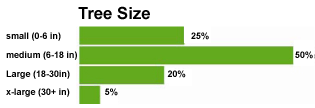
Condition. Just over 90% of the trees were rated in good to excellent condition.
Size. Census takers measured the girth of each tree at chest height. Onequarter of all street trees citywide are small, with Manhattan having the highest percentage of small trees (35%). Five percent of trees are extra large (over 30 inches wide), with Queens having the highest percentage of extra large trees (6.3%). Most (70%) of the City's largest street trees are comprised of just three species: London planetree, pin oak, and silver maple. By contrast, there is much greater species diversity in the small tree population (14 species in the first 70%).
Damage. Street trees are located on the busy interface between humans and nature, and as such are vulnerable to environmental and physical damage. Signs of damage include torn bark, wounds or cavities on the trunk and branches. Causes of such damage can include vehicles, vandals, or animals. Over 15% of our street trees have trunk wounds (89,211), with 6.6% having torn bark (39,524) and 5.3% with cavities of some type (31,103).
Urban Conflicts
| # trees | % total | |
|---|---|---|
| Overhead wires | 209,171 | 35.8% |
| Raised sidewalks | 100,829 | 13.9% |
| Cracked sidewalks | 65,299 | 9.0% |
| Close Paving | 43,409 | 6.8% |
| Choking wires | 13,865 | 2.2% |
| Canopy debris | 7,341 | 1.2% |
| Choking Guard/Grate | 3,918 | 0.6% |
| Tree Lights | 2,526 | 0.4% |
| Electric Outlet | 1,875 | 0.3% |
| Sneakers | 437 | 0.0% |
Conflicts. Overhead wires are the predominant urban infrastructure that conflict with trees in all neighborhoods in New York City with the exception of Manhattan. More than 35% of the City's street trees are growing under wires. Other urban conflicts common to street trees are listed below.
Preliminary Management Observations. With the data from the census, there are a few key insights that have begun to emerge that will help us as we go forward:
- London planetree is our most important species and should always have some representation in our tree population;
- Almost 31% of our street tree species are susceptible to the Asian Longhorned beetle and our planting practices need to continue to strive for increased diversity, and reduced susceptibility to pests and diseases;
- Large, canopy trees confer the most benefits and we need to continue to focus on planting large tree species that will successfully mature.
Did You Know?
A 31 inch wide sweetgum in Queens is 134 years old. Though not the oldest or the largest street tree in the City, it is the oldest of those that we have measured by counting tree rings.
Then & Now
- In the 1995-1996 census, Norway maple comprised almost 23% of the street tree population and was the most populous species. It has now dropped to 14% of the population. The explanation? Over the past decade this species has made up more than 60% of all dead tree removals due to poor health.
- In the 1995-1996 census, over 2% of the population was dead at the time of the inventory (13,154 trees). This time, despite counting almost one-fifth more trees, only 1.4% (8,113) were found to be dead. What changed? Parks instituted a new dead tree removal service commitment, whereby dead trees are removed within 30 days of request. Parks meets this commitment 95% of the time.
The 2005-2006 census effort mobilized an unprecedented number of volunteers. Over 1,100 volunteers participated, logging 30,000 volunteer hours.
Recruitment. Parks cast a wide net to recruit census volunteers in all five boroughs. Most of the volunteers found the tree census through newspapers, the internet, word-of-mouth, and Parks-affiliated groups. The typical volunteer was female, aged 41-60, employed full time, with a college or advanced degree, and has lived in New York City for at least twenty years. *
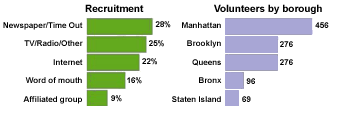
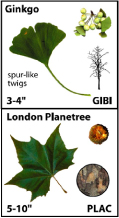
Training.All volunteers were required to attend one 3-hour indoor training session and had an option to attend an outdoor session as well. We offered 111 training classes in all five boroughs on evenings and weekends. Volunteers received a 123-page training manual, clipboard, data collection forms, diameter measuring tape, a zone map, and a Trees Count t-shirt (see example below).
Support. After the mandatory training session, volunteers received ongoing support and encouragement. Parks sent weekly email or snail mail updates. We established a dedicated email account and telephone number, along with a website where volunteers could download training information and participate in an on-line bulletin board (see example below) that received 521 postings. One volunteer posted the following observation: “Lots of people ask me what I am doing. I tell them I'm counting the trees, and they look at me very strangely and walk away quickly!” One volunteer, dubbed “Treewright”, helped to answer many of the questions posted by others. All volunteers who submitted data were automatically entered into monthly raffles offering free tickets and entry to events and gardens throughout the city. Parks feted volunteers at a series of thank you parties held in each borough.
Beyond Volunteers. While volunteers provided the core of the census workforce, Parks turned to its Americorps initiative (the Green Apple Corps), an urban forestry consulting group, and Parks own staff to complete the effort. Volunteers completed 42% of the census.
Did you know?
- Volunteers contributed 30,000 hours of their own time to the census. At an hourly rate of $8, the value of their work would have been $240,000.
- There was a 57% increase in volunteer participation from the 1995-1996 census, increasing from 700 to 1,100.
- 85% of the census volunteers were new to the Parks Department.*
- 95% of the volunteers said they would volunteer again.*
- The volunteer contributing the most to the tree count recorded 4,891 sites.
- The volunteer entering the most trees into the database logged 9,369 entries.
From Our Volunteers
"Good experience. I loved learning tree types and 'meeting' the trees in my zone. I would be pleased to know I contributed to the city investing in more trees."
"I am so happy I had the chance to do this. It was a wonderful opportunity to learn more about trees - better than going to school for botany!!"
"I really had a great time. I also encountered some amazing streets right next to each other. Some were monocultures and some had a wide variety of trees. The reaction from homeowners and pedestrians was also very positive and rewarding. With the very large diameter trees I asked pedestrians for help in measuring and it was always interesting to see New Yorkers offer assistance. Hope to be able to help in 10 years for the next one."
Technology was a hallmark of the 2005-2006 street tree census. Parks used computer mapping, email, the internet, and handheld computers to recruit volunteers, report our progress and anaylze results, while only ten years ago we relied 100% on paper, copy machines and highlighters.
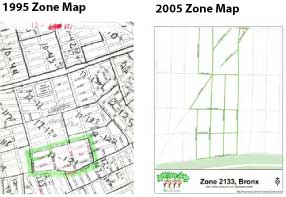
Computer Mapping. In 1998, Parks used Geographic Information Systems (GIS) to map the 1995-1996 census results. We used that information to organize the 2005-2006 effort, creating zones of approximately 300 trees each. These zones served as the organizing unit for the census. Each volunteer was asked to commit to one zone, we customized our recruitment efforts by mapping assigned zones and we provided a custom designed GIS zone map for each volunteer.
Using the most up to date New York City Department of Planning's GeoSupport application, the census data was mapped providing a basis for borough and neighborhood scale spatial analysis in ArcGIS. For example, the mapped census data will allow us to estimate how many additional trees could be planted on every block in all five boroughs.
Email. While email is a vital part of any business transaction or public program today, it was still in its infancy during the last census effort. Staff used email extensively to recruit volunteers and communicate with them through weekly updates and other notices.
Trees Count Website
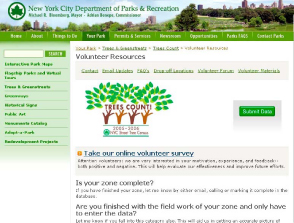
FoRMS Sample Web Interface
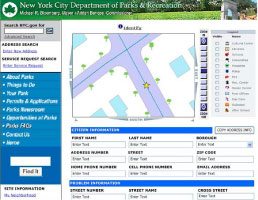
Website. Parks designed a completely interactive census website where volunteers could:
- View a training calendar and register for classes;
- Access resources including the training manual, data collection, forms, and the leaf key;
- View weekly census updates;
- Communicate with other volunteers through a facilitated bulletin board;
- Enter tree census data into an online form;
- Participate in a volunteer survey.
Handheld computers. Hewlett Packard donated 40 handheld computers. The Davey Resource Group’s professional staff designed a customized database to put on the handhelds that matched the paper data forms so their data could be easily imported into Parks’ online database. This bypassed the data-entry phase and saved paper and trees.
Forestry Management System (FoRMS). This fall, Parks will roll out a GIS-based application for tracking our tree inventory and work orders. Using a map-based application for everyday operations will revolutionize how Parks manages our urban forest. By tracking our inventory and work orders within a map of our city, Parks will be able to manage every tree in relation to other trees and infrastructure such as roads, highways and buildings. FoRMS will also allow people to submit and track requests on the Parks website.
Did you know?
- 20% of the census was collected on handheld computers.
- The new online forestry management tool will allow users to see individual trees in their neighborhoods, and track requests related to them.
Our street trees work for us every day, providing benefits that directly improve our quality of life. Trees purify and cool the air, reduce stormwater runoff, and conserve energy. They increase property values, beautify neighborhoods, and improve human health and well-being. Until recently, it was very difficult to put a dollar value on these benefits. But now scientists with the U. S. Forest Service have developed a way to assess the bottom line impact of many–but not all–benefits of urban trees.
Benefits are directly linked to tree size. The environmental benefits of trees arise from respiration and transpiration – the biological processes by which trees breathe and absorb water from the environment. Because these processes involve interactions between a tree’s leaves, the environment, and the atmosphere, the benefits increase as trees grow in size. In general, the larger a tree, the more canopy cover and leaf surface area (the total area of the leaf spread) it has.
How do we take tree measurements? Measuring the canopy size, leaf surface area and total organic matter (biomass) for every tree would be impossible. Instead, scientists designed a method to sample a small number of trees that would provide data that could be extrapolated to the entire tree population.
Modeling tree growth to predict benefits. The U.S. Forest Service can model tree growth by individual species according to different climate regions. When information about tree size and species is fed into the growth model, it yields an estimate of canopy size, leaf area and biomass for every street tree in that region. Tree benefits can then be calculated using local data including hourly climate and air pollution concentrations, local energy costs, power plant fuel types and emissions, and building construction information. The benefits are detailed below.
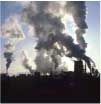 Air Quality Improvement. Leaves absorb gaseous pollutants (carbon dioxide, nitrogen dioxide, and sulfur dioxide), and capture air-borne particles including dirt, dust and soot. Trees also prevent the release of many airborne pollutants by reducing energy generation. Ground level ozone, a contributor to greenhouse gas formation, is reduced through the tree’s ability to lower air temperatures.
Air Quality Improvement. Leaves absorb gaseous pollutants (carbon dioxide, nitrogen dioxide, and sulfur dioxide), and capture air-borne particles including dirt, dust and soot. Trees also prevent the release of many airborne pollutants by reducing energy generation. Ground level ozone, a contributor to greenhouse gas formation, is reduced through the tree’s ability to lower air temperatures.
ANNUAL BENEFIT VALUE: TO NYC: $5.3 MILLION- Energy Savings. Trees provide shade, reducing the demand for electricity for cooling in the summer. Trees also reduce wind speeds, slowing the loss of heat from interior spaces during the winter. Trees cool the air through the process of transpiration, where moisture is converted to water vapor. An estimate for energy usage for every building in NYC was derived from data on building age, tree shading effects, and local climate. This estimate was drawn with two scenarios–with and without street trees–in order to show the difference in the resulting energy use. Local energy prices were then used to calculate the value of the impact of trees on building energy use.
ANNUAL BENEFIT VALUE TO NYC: $27.8 MILLION  Carbon Dioxide (CO2). Trees indirectly reduce emissions of CO2 from power plants by reducing building energy use. Also as trees grow, they remove CO2 from the atmosphere and store it in woody plant tissue. At the same time, trees release CO2 as they decompose. These releases are subtracted from the total amount of CO2 avoided from power generation and absorbed by tree growth to calculate the net CO2 benefit.
Carbon Dioxide (CO2). Trees indirectly reduce emissions of CO2 from power plants by reducing building energy use. Also as trees grow, they remove CO2 from the atmosphere and store it in woody plant tissue. At the same time, trees release CO2 as they decompose. These releases are subtracted from the total amount of CO2 avoided from power generation and absorbed by tree growth to calculate the net CO2 benefit.
ANNUAL BENEFIT VALUE TO NYC: $754,947 Reducing Stormwater Runoff. Trees help reduce flooding and improve water quality, as runoff flowing over impervious surfaces picks up contaminants including oil and metals. Trees intercept rain on their leaf, branch and stem surfaces and by absorbing water through their roots. The water that trees intercept in NYC each year was calculated using local rainfall data.
Reducing Stormwater Runoff. Trees help reduce flooding and improve water quality, as runoff flowing over impervious surfaces picks up contaminants including oil and metals. Trees intercept rain on their leaf, branch and stem surfaces and by absorbing water through their roots. The water that trees intercept in NYC each year was calculated using local rainfall data.
ANNUAL BENEFIT VALUE TO NYC: $36 MILLION Property Value and Other Benefits. Research has shown that homes with a tree in front sell for almost 1 percent more than similar homes without trees. The difference in sale price indirectly reflects the value buyers place on trees and their more intangible benefits, such as aesthetics. This difference was applied to the median New York City home resale price ($537,300) to calculate the total value.
Property Value and Other Benefits. Research has shown that homes with a tree in front sell for almost 1 percent more than similar homes without trees. The difference in sale price indirectly reflects the value buyers place on trees and their more intangible benefits, such as aesthetics. This difference was applied to the median New York City home resale price ($537,300) to calculate the total value.
ANNUAL BENEFIT VALUE TO NYC: $52 MILLION
TOTAL ANNUAL BENEFIT VALUE TO NYC: $122 MILLION
Did You Know?
- A large, healthy tree removes almost 70 times more air pollution each year than a small, newly planted tree.
- London planetrees remove more than 77 tons of air pollution each year, over one-quarter of all pollutant removal by NYC?s trees.
- Each year 272 tons–the equivalent of 40 adult elephants–of air pollution are intercepted or absorbed by trees in NYC.
- Average electricity and natural gas cost savings in NYC are $47 per street tree
- Each year 313 tons of air pollution are avoided because of energy savings resulting from reduced emissions.
- The average street tree in NYC intercepts 1,432 gallons of stormwater each year; all our street trees capture 890 million gallons per year.
Citywide, the 2005-2006 census showed that our tree population grew by almost 19% since the last count. A breakdown by borough gives greater detail on the distribution, composition, and condition of our street trees.
The borough with the largest increase in trees counted between the two census efforts is Staten Island (32.5%), followed by Brooklyn (27%) and the Bronx (25%).
| Borough | 1995-1996 | 2005-2006 | % Increase |
|---|---|---|---|
| Bronx | 47,995 | 60,004 | 25% |
| Brooklyn | 112,400 | 142,747 | 27% |
| Manhattan | 45,793 | 49,858 | 9% |
| Queens | 217,111 | 239,882 | 10% |
| Staten Island | 75,171 | 99,639 | 33% |
Bronx
| Species | % of population |
|---|---|
| Honeylocust | 13 |
| Norway maple | 12 |
| London planetree | 11 |
| Pin oak | 9 |
| Callery pear | 8 |
Brooklyn
| Species | % of population |
|---|---|
| London planetree | 24 |
| Norway maple | 11 |
| Honeylocust | 9 |
| Pin oak | 7 |
| Callery pear | 7 |
Manhattan
| Species | % of population |
|---|---|
| Honeylocust | 23 |
| Callery pear | 16 |
| Gingko | 10 |
| London planetree | 8 |
| Littleleaf linden | 6 |
Queens
| Species | % of population |
|---|---|
| Norway maple | 18 |
| London planetree | 14 |
| Pin oak | 8 |
| Callery pear | 7 |
| Honeylocust | 7 |
Staten Island
| Species | % of population |
|---|---|
| Callery pear | 25 |
| London planetree | 10 |
| Red maple | 9 |
| Norway maple | 8 |
| Pin oak | 7 |
Species. London planetree may be the most common species citywide, but it is number one only in Brooklyn (23.6%). In the Bronx and Manhattan, honeylocust is the most plentiful street tree (12.9% and 23.3% respectively), while in Queens the honor still goes to the Norway maple (18.3%). The top five street tree species in each borough are shown in the charts to the left.
Diversity. The more species comprise a population, the less impact pests and diseases can have on the health and vitality of the whole population. A population that lacks species diversity is termed a monoculture. A general rule of thumb when measuring diversity is to assemble a population with no greater than 10% of any species. Another measure of diversity is the extent to which a single species dominates a population. In general, no one species should exceed 25% of a population. By this measure, Brooklyn (London planetree), Manhattan (honeylocust), and Staten Island (Callery pear) show significant dominance by the most plentiful species.
Condition. Just over 90% of the trees were rated in good to excellent condition, with the remaining trees judged to be in poor condition (8.3%) or dead (1.4%). Staten Island has the highest number of trees in good and excellent condition (94%), with Brooklyn (91%) and Queens (90%) close behind. The Bronx had the highest number of trees in poor and dead categories (12%), followed by Manhattan (11.3%) and Queens (10%).
Conflicts. Overhead wires are the predominant urban infrastructure that conflict with trees in all neighborhoods in New York City with the exception of Manhattan. More than 35% of the City’s street trees are growing under wires. Other urban conflicts common to street trees are listed below.
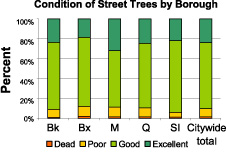
Preliminary Management Observations. With the data from the census, there are a few key insights that have begun to emerge that will help us as we go forward:
- London planetree is our most important species and should always have some representation in our tree population;
- Almost 31% of our street tree species are susceptible to the Asian Longhorned beetle and our planting practices need to continue to strive for increased diversity, and reduced susceptibility to pests and diseases;
- Large, canopy trees confer the most benefits and we need to continue to focus on planting large tree species that will successfully mature.
| Borough | Damaged Sidewalks | Canopy Debirs | Choking Wires | Close Paving | Choking Grate | Tree Lights | Electric Outlet |
|---|---|---|---|---|---|---|---|
| Bronx | 8,867 | 879 | 1,858 | 2,232 | 270 | 203 | 353 |
| Brooklyn | 28,424 | 2,625 | 3,632 | 17,436 | 1,070 | 554 | 172 |
| Manhattan | 2,984 | 1,451 | 772 | 1,373 | 1,193 | 771 | 929 |
| Queens | 49,245 | 2,034 | 6,161 | 18,258 | 813 | 702 | 324 |
| Staten Island | 11,309 | 352 | 1,442 | 4,110 | 572 | 296 | 97 |
| Citywide Total | 100,829 | 7,341 | 13,865 | 43,409 | 3,918 | 2,526 | 1,875 |
Tree Benefits. The value of the street trees in each borough can be quantified in terms of the amount of air pollution removed, emissions avoided, stormwater runoff intercepted, and energy saved. In addition, street trees increase property values. The dollar value of the trees in each borough are shown below (in 000s).
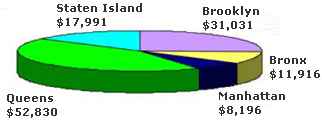
Tree Benefits Details (in 000s)
| Borough | Energy< | CO2 | Air Quality | Stormwater | Property Values | Total |
|---|---|---|---|---|---|---|
| Bronx | $2,699 | $73 | $505 | $3,300 | $5,339 | $11,916 |
| Brooklyn | $7,352 | $195 | $1,378 | $9,409 | $12,697 | $31,031 |
| Manhattan | $1,646 | $42 | $293 | $1,804 | $4,411 | $8,196 |
| Queens | $12,308 | $342 | $2,375 | $16,238 | $21,567 | $52,830 |
| Staten Island | $3,814 | $103 | $719 | $4,877 | $8,478 | $17,991 |
| Total | $27,818 | $755 | $5,270 | $35,628 | $52,492 | $121,964 |
PlaNYC
- Mayor Bloomberg’s vision for a greener, greater New York City includes the following programs to enhance our urban forest infrastructure:
- $40 million in total funding to fix over 20,000 sidewalks that are severely damaged by tree roots in a way that promotes tree and sidewalk longevity.
- $2 million each year to remove stumps as part of the new tree planting process.
To achieve our management, education, research, and planning goals, Parks carefully identified the relevant information to collect for each tree. Parks collected three times the amount of data during the 2005-2006 effort than it did in the 1995-1996 census, tracking over 15 million pieces of information.
Location. So Parks could find its way back to a tree that was surveyed, fully one-third of the volunteer training session focused on how to use an address to assign trees to the nearest building.
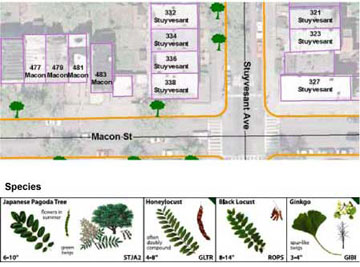
Species. We developed a Leaf Key to identify trees. Volunteers were trained to identify both genus and species, given a photo guide of 54 species and an additional choice of 72 species online.
Size. Using a measuring tape specifically designed to calculate tree diameter from a circumference measurement, census workers measured the tree at a standard 4.5 feet from the ground (or breast height).
Condition. Staff developed a simple assessment system using leaf health, branch structure, and trunk condition geared toward an amateur workforce. Condition ratings were broad—excellent, good, poor, and dead—and comparable to those used in the 1995-1996 census.
Site Type. We recorded whether a tree was growing in a lawn area, an individual sidewalk pit, or a shared sidewalk cutout (see below).
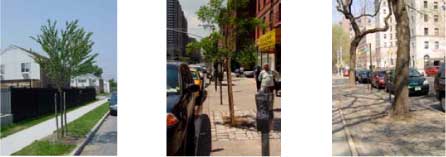

Soil Level. We asked if the soil level is at least one inch below the sidewalk grade, if the soil is piled around the base of the trunk, or if the soil is level with the sidewalk.
Sidewalk Condition. Assessing the sidewalk directly adjacent to the tree opening, surveyers noted cracks and raised paving.
Vertical Treatment. Census takers noted fencing around the perimeter of a tree pit, those close to the tree, and solid walls built around the trees.
Horizontal Treatment. We looked for granite, concrete, or other blocks installed in tree pits at sidewalk grade and identified metal grating as well as decorative planting.
Overhead Wires. Beyond redcording their existence, volunteers identified the type of overhead utility wires—primary, secondary, or house tap—to help guide our pruning and planting work.
Infrastructure Conflicts. We documented anything harming or restricting the growth of the tree including canopy debris, choking wires, close paving, choking tree guards and grates, tightly wrapped tree lights, electric outlets, and sneakers.
Trunk Damage. Census takers recorded the presence of torn bark, trunk wounds, and cavities.
Tree Pit Status. The census looked at more than just living trees. We included dead trees, shafts (standing dead trees with branches removed), stumps (trees cut to the ground) and empty tree pits.
Did you know?
- Over 15 million pieces of data were collected, entered, and analyzed as a result of the census effort.
- Parks divided the city into 1,649 zones, and used these units to track our progress in recruiting volunteers, and collecting and entering data.
Then & Now
The 1995-1996 census used over eight fields of data while the latest effort included 27 pieces of data. Many new fields were required to do the environmental benefits analysis (STRATUM), and inform management decisions.